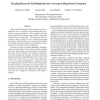Free Online Productivity Tools
i2Speak
i2Symbol
i2OCR
iTex2Img
iWeb2Print
iWeb2Shot
i2Type
iPdf2Split
iPdf2Merge
i2Bopomofo
i2Arabic
i2Style
i2Image
i2PDF
iLatex2Rtf
Sci2ools
MICRO
2006
IEEE
2006
IEEE
Merging Head and Tail Duplication for Convergent Hyperblock Formation
VLIW and EDGE (Explicit Data Graph Execution) architectures rely on compilers to form high-quality hyperblocks for good performance. These compilers typically perform hyperblock formation, loop unrolling, and scalar optimizations in a fixed order. This approach limits the compiler’s ability to exploit or correct interactions among these phases. EDGE architectures exacerbate this problem by imposing structural constraints on hyperblocks, such as instruction count and instruction composition. This paper presents convergent hyperblock formation, which iteratively applies if-conversion, peeling, unrolling, and scalar optimizations until converging on hyperblocks that are as close as possible to the structural constraints. To perform peeling and unrolling, convergent hyperblock formation generalizes tail duplication, which removes side entrances to acyclic traces, to remove back edges into cyclic traces using head duplication. Simulation results for an EDGE architecture show that conver...
Convergent Hyperblock Formation | Edge Architecture | Hardware | MICRO 2006 | Scalar Optimizations |
| Added | 12 Jun 2010 |
| Updated | 12 Jun 2010 |
| Type | Conference |
| Year | 2006 |
| Where | MICRO |
| Authors | Bertrand A. Maher, Aaron Smith, Doug Burger, Kathryn S. McKinley |
Comments (0)

